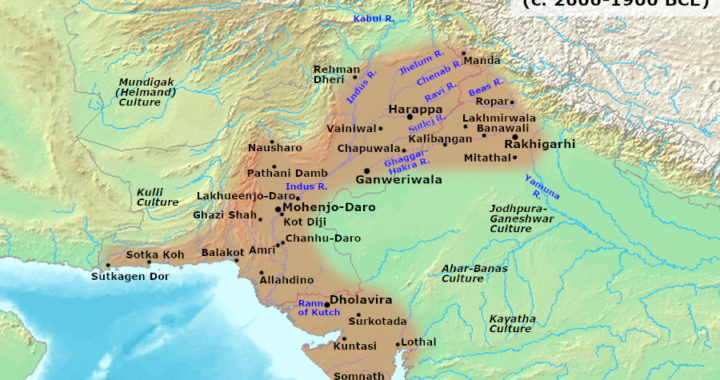
Harappans were best known for their advanced water management and the systematic grid planning of cities. They were farmers, traders, and skilled workers. So far archeologists have excavated more than 1000 sites of the civilization. Here are a few most important sites which have some unique features.
Harappa

- The Harappa is located on the banks of the river Ravi
- It was the first site to be excavated among all the Indus sites. So, the Indus valley civilization was initially called the Harappan civilization.
- Apart from food production, a substantial section of people was engaged in activities like administration, trade, craft, or religion.
- The granaries in Harappa are located outside the citadel
- Rows of single-roomed quarters are located just below the walls of the citadel. These rooms were probably meant for laborers
- Red sandstone naked man’s torso has been found in the excavations of Harappan sites which indicates traces of Jainism. This man is identified as Hariyupiya of Rig Veda

- The location of Harappa has made several authors conclude that it was a “Gateway city”
- Coffin-burial only found in the Harappa.
Mohenjo-Daro

- The Mohenjo-Daro is located on the banks of the river Indus. It is considered one of the capitals of the Indus system.
- In the Sindh language, Mohenjo-Daro means “mound of death”
- It was the largest Harappan city, with a population of about 35,000
- Excavations suggest that people lived here for a very long time. They went on building and re-building houses at the same location. And as a result, the height of the debris is about 75 feet.
- Mohenjo-Daro along with Harappa hailed as twin capitals and Kalibangan served as its subsidiary.
- The following are the important findings of Mohenjo-Daro,

- 1. Great Bath of Mohenjo-Daro
- It is a very important public place located at the center of the citadel.
- It is remarkable for the beautiful brickwork.
- Its floor is made of burnt bricks set with gypsum and mortar.
- It measures about 39 feet in length, 23 feet in breadth, and 8 feet in depth.

- 2. Great Granary of Mohenjo-Daro
- It is the largest building in Mohenjo-Daro.
- It is located within the citadel.
- It measures about 150 feet in length and 50 feet in breadth.
- Multi-pillared assembly hall
- An oblong multi-pillared assembly hall and a big rectangular building which has served the purpose of administration. It is located in the citadel.
Kalibangan (Rajasthan, India)
- It is located on the dried-up river bed of river Ghaggar
- It was excavated in 1960 under the guidance of BK Thapar
- The literal meaning of Kalibangan is “black bangle”
- Kalibangan area has the largest concentration of Harappan settlement
- It has yielded evidence of the early Harappan period.
Lothal (Gujarat, India)
- It is located in the coastal flats of the Gulf of Cambay beside a tributary of the river Sabarmati.
- It was an important center for making objects out of stone, shells, and metal.
- The most important feature of this is a dockyard. It was the main sea-port of the Indus people.
- Lothal has the evidence of cultivation of rice.
- Many tools, stone beads, and seals are found in Lothal. The most famous among them is the ‘Persian Gulf seal’
- The shops of metal workers, Stone bead, and seal workers were also found in the excavations.
- Lothal served for long-distance trade and also supplied the Indus cities with raw materials like cotton from Gujarat and copper from Rajasthan.
Dholavira
- It is located on Khadir bet in Run of Kutch.
- This settlement is dived into three parts, unlike other settlements which are divided into two. Two of these three are surrounded by massive stone walls with entrances through gateways.
- There was also a large open space inside the settlement which could have probably served the purpose of public meetings
- The most startling feature of Dholavira is the Giant reservoir for holding water.
- The excavations also revealed an inscription with ten large-sized signs of Harappan script.
Suktagendor
- It is located near the Makran coast which is close to the Pakistan-Iran border.
- This settlement is landlocked and located in dry and inhospitable plains
- The citadel of this settlement is surrounded by a stone wall which could have been built for the purpose of defense
- It was used as the trade point between Harappa and Babylon.
Other Important sites
- Chanhudaro is the only Indus site with no citadel
- Banawali, located in the Hissar district of Haryana
- Surkotada, the only Indus site where the remains of Horses are found
- Ropar is the first site to be excavated after independence. Evidence of burying a dog with a Human burial is an interesting feature here.
- Rakhigarhi is located in the Hissar district of Haryana. It is termed the provincial capital of the Harappan civilization
- Balakot was the major center of the shell industry.

